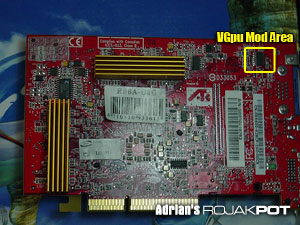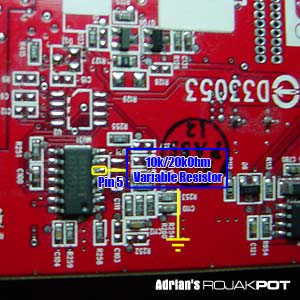GPU Voltage Mod - Resistor Method (Continued)
After obtaining your graphics card's GPU voltage, turn off your computer and remove your card. Place it in a clear and brightly-lit workspace and look for the are outlined in the picture below.
Identify the ISL6522CB voltage regulator.
You will need to connect pin 5 of the voltage controller to the variable resistor. Then, connect a wire from the resistor to a ground point. You can choose pin 7 of the voltage controller or a motherboard screw hole as the ground point.
Don't forget to check the connections with a magnifying glass to make sure they are connected flawlessly and do not come into contact with nearby components.
After you have soldered the wires and double-checked them, remember to set the 10,000 Ohm variable resistor to the highest resistance! Forgetting this step may cost you your card!
Then turn on your computer and measure the GPU voltage again. The multimeter will record a higher GPU voltage, even with the variable resistor set to its highest resistance.
Now, turn off your computer and give the variable resistor a slight turn to reduce the resistance a little. Then, turn on your computer and measure the GPU voltage again. The multimeter will show an increase in the GPU voltage. Repeat these steps until you attain your desired GPU voltage. But remember, never attempt this with stock cooling! Also, even with very good cooling, i wouldn't recommend you to go above 1.7V or 1.8V. Giving the core too much voltage increase is never a good idea and will shorten the life-span of the card constantly.
Some of you may be wondering if it is possible to adjust the voltage "on-the-fly" - adjusting the variable resistor with the system turned on. Yes, that is possible. However, I strongly discourage you from doing that because an accidental twist of the variable resistor may inadvertently raise the voltage way too high and kill the GPU.
<<< GPU Voltage Mod - Resistor Method : Previous Page | Next Page : GPU Voltage Mod - Pencil Method >>>







 Add to Reddit
Add to Reddit


